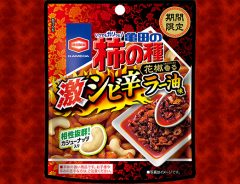
Photo by grape Japan
Japan’s most famous rice cracker snacks now come in big sizes with premium flavors [review]
- Tags:
- Big / kaki no tane / Kameda Seika / otsumami / premium / rice crackers / Snack
Related Article
-

The Best Onigiri You Can Buy In Japanese Convenience Stores
-

Veggie Donuts for the Health-Conscious: OKdoughnuts
-

Totally nuts! Japanese cracker maker to sell famous rice cracker peanut mix without crackers
-

“Gotta be delicious!”; “Genius!”: Try Japanese agriculture group’s egg recipe for dinner tonight
-

Mild-Mannered Kaki no Tane Rice Crackers Get Super-Spicy Tongue-Tingling Makeover
-

Welcome fall with these gorgeous grape cakes from Café Comme Ça


You may have seen them in a Japanese bar or maybe in a snack mix at an Asian supermarket. Known as 柿の種 kaki no tane (literally, "persimmon seeds"), the small, orange, crescent-shaped rice crackers with a soy sauce base and a mild chili pepper taste have been enjoyed since the Taisho Era in Japan.
Several companies make kaki no tane in Japan, but the largest producer is Kameda Seika Co., Ltd., which is famous for its 柿ピー kakipī combination with peanuts, a Japanese favorite since 1966.
Through the years, Kameda Seika has experimented with different flavors, such as wasabi, pickled plum and perilla, yuzu pepper, extra spicy, and even limited-edition flavors like Sichuan spice and double cheese.
However, one thing that has never changed is their size. Their snacks are usually around 2 to 2.5 centimers tall, or about an inch.
So, when we learned that they were releasing a new series of kaki no tane with a big size and premium flavors, our curiosity was piqued.
大粒の柿の種 Big Kaki no Tane
We picked up the three flavors of 大粒の柿の種 ōtsubu no kaki no tane, literally "big kaki no tane, that were available at our local Lawson convenience store.
In the photo below, from left to right: 明太子風マヨネーズ味 (mentaiko-fū mayonēzu aji | Metaiko-style mayonnaise flavor), 旨醤油とうがらし (uma shōyu tōgarashi | tasty soy and chili pepper), and 海鮮風黒こしょう味 (kaisen-fū kurokoshō aji | Seafood-style black pepper flavor).
Photo by grape Japan
These premium flavors already sounded enticing but we were curious to find out how they actually tasted.
The series is part of Kameda Seika's tsumamoon series. Tsumamoon is a play on words on the Japanese verb つまむ tsumamu, meaning both "pick up" or "pinch" with your fingers, and by extension, to nibble or snack on finger food (hence the noun おつまみ otsumami, meaning "snack" or "finger food," usually paired with a drink). The slogan on the package says つまめる贅沢おつまみ tsumameru zeitaku otsumami, meaning "premium otsumami you can easily pick up." Since kaki no tane are so small, it's common for people to grab a bunch of them in the palm of their hand and pop them in their mouths. The idea is that these larger versions can more easily be held and individually savored.
Photo by grape Japan
The colors already made them stand out from the standard dark orange kaki no tane we were used to.
But were they really big? To find out, we needed to buy a bag of regular kaki no tane and compare them side by side...
Photo by grape Japan
It's not an exact science, but we reckoned that they were about twice as large. They were indeed easy to hold, as advertised.
As for their taste, they were all quite good. 明太子風マヨネーズ味 (mentaiko-fū mayonēzu aji | Metaiko-style mayonnaise flavor) was our favorite, combining the rich seafood taste of mentaiko (salted cod roe with a slight spicy flavor) and the creaminess of mayonnaise.
旨醤油とうがらし (uma shōyu tōgarashi | tasty soy and chili pepper) was the most similar to the standard kaki no tane, with perhaps a stronger soy flavor. The spice of the chili pepper was hardly noticeable, however. Finally, 海鮮風黒こしょう味 (kaisen-fū kurokoshō aji | Seafood-style black pepper flavor) taste somewhat like butter and scallops with a very mild pepper kick.
We would gladly snack on these if they were served at a bar.
If you can find these at your local Lawson or other shops where snacks are sold, why not give them a try? Other flavors are also available.
By - grape Japan editorial staff.